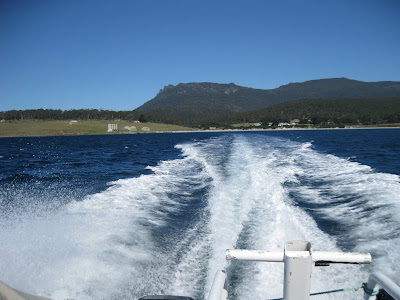The 1 hour flight tracks over historic Port Arthur then south to Tasman Island before heading north up Tasmania's East Coast along an amazing coastline of gleaming sandy beaches, dolerite cliffs and sea stacks.
Tasman Island, Tasmania
A fly over of Maria Island reveals the route that the Maria Island Guided Walk will take us over the next 4 days.
Darlington Airfield
Another perfect landing on the northern tip of Maria Island, and then we are off on our 4 day adventure.
Darlington, the main settlement of Maria Island, was once a Probation Station that was established in 1825.
Many of the original buildings still remain and they have been fully restored, including the Penitentiary Cells, which have been turned into public accommodation. We will be staying there on our last night of the tour.
The tour breezes through Darlington, then heads south towards the Painted Cliffs. The patterns in the sandstone cliffs here are truly amazing. Our guides take us to some hidden gems that are really seen!
Painted Cliffs, Maria Island
There are surprises around every corner on our walk, pristine beaches, wombats for miles, gangs of Yellow Tail Black Cockatoos overhead and the smells of the forests and ocean.
French's Farmhouse Circa 1930
French's Farm was our base camp for 2 nights and the evenings were fantastic. We watched grazing wombats and wallaby's while we enjoyed a few fine Tasmanian wines.
Day 2 has a couple of walking options, and due to the perfect weather, the guides decided to take us to Haunted Bay, which is as far south that the walking track can take us.
Haunted Bay
Haunted Bay is amazing! It's a fair walk to get there but you are rewarded by fantastic views and the feeling of remoteness. The bay is the home to nesting Little Penguins and it was once a shore based whaling station in the early 1800's.
Our guides whipped up a fantastic picnic lunch, then we retraced our footsteps back to French's Farm.
Summit view from Mount Maria 710m
Back at Darlington we were immersed in the history of the island. The probation station has been restored to its former glory and we got sleep comfortably in the converted Penitentiary Cells that once interned over 600 convicts.
Darlington Probation Station
On day 4 our guides took us on an amazing exploration around the northern part of Maria Island. We poked our heads into numerous historical buildings and we had some incredible vistas.
Mount Bishop & Clerk viewed from Skipping Ridge
Its was an incredible 4 day adventure. Our hosts were Stan & Senna from The Maria Island Guided Walk and we look forward to coming back soon.
Leaving Maria Island by ferry





















